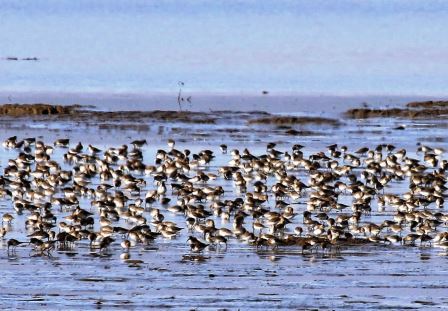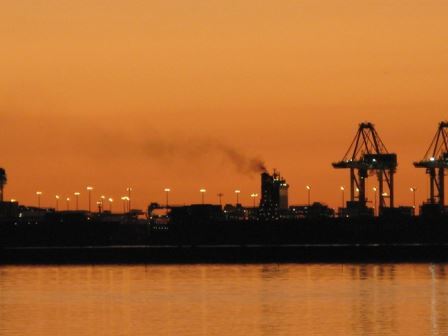(The following article was contributed by the Community Group – Against Port Expansion in the Fraser Estuary – www.againstportexpansion.org)
A proposed project by Port Metro Vancouver (PMV) is moving forward that will have a significant impact on Metro Vancouver, many communities in the Lower Mainland and the Gulf Islands.
Port Metro Vancouver intends to build a huge man-made island (one third the size of Stanley Park – Vancouver BC), for a second container terminal (T2) on Roberts Bank, next door to the existing three-berth Deltaport Container Terminal.
This is slap-bang in the middle of the Fraser Estuary. Roberts Bank is a dynamic estuarine environment, the very fulcrum of one of the top ten “Most Important Bird Areas” in the world and the ecological crucible of the Fraser Estuary.
Roberts Bank Container Terminal 2 Environmental Impact Statement
The Environmental Impact Statement for the Roberts Bank Container Terminal 2 (T2) project was released to the public in April 2015. However, here we are seven months later and there is still no opportunity to comment on its sufficiency and technical merit.
Therefore, deciding that they have waited long enough, the Against Port Expansion Community Group has now written and published a report, entitled “Port Metro Vancouver’s Roberts Bank Container Terminal 2 Is Not Sustainable – It Must Never Be Built.”
Download the report: Port Metro Vancouver T2 Development Is Not Sustainable Nov 2015 (748 KB)
The extensive report reviews this project and finds it lacking in terms of its sustainability – being a balance between the economic, environmental and socio-community aspects. The Community Group will be filing this report with the Canadian Environmental Assessment Agency as soon as they are permitted to do so.
Wildlife Habitat Must be Preserved
 Conservation of important wildlife habitat is an international responsibility and Canada is falling short. Roberts Bank sits on the Pacific Flyway and is one of only six major stopping places where waterfowl and shorebirds pause to feed on their long journey between Central and South America and their Arctic breeding grounds. Loss of habitat and disturbance by port development on Roberts Bank is already having an impact on birds, waterfowl, fishes, whales and other wildlife. This second container terminal would be the tipping point. It cannot be allowed to proceed.
Conservation of important wildlife habitat is an international responsibility and Canada is falling short. Roberts Bank sits on the Pacific Flyway and is one of only six major stopping places where waterfowl and shorebirds pause to feed on their long journey between Central and South America and their Arctic breeding grounds. Loss of habitat and disturbance by port development on Roberts Bank is already having an impact on birds, waterfowl, fishes, whales and other wildlife. This second container terminal would be the tipping point. It cannot be allowed to proceed.
Container Terminal Business Case is Weak
 It is bad enough that the Port would consider a second container terminal in this highly significant environmental area, used by millions of shorebirds, by salmon, by whales and many other wildlife species.
It is bad enough that the Port would consider a second container terminal in this highly significant environmental area, used by millions of shorebirds, by salmon, by whales and many other wildlife species.
It is equally concerning that the business case for this container terminal is weak. It simply cannot be justified because there is plenty of spare current container port capacity as well as large expansions at existing container terminals coming on stream in the next five years that will increase container terminal capacity on the West Coast of Canada by about 70 percent. Not only that but the Port seems intent on poaching more US bound containers (which adds nothing to the Canadian economy) despite the fact that neighbouring US ports have lots of spare capacity – with Seattle/Tacoma ports planning to increase from 3.5 million containers to 6 million by 2020. In short the West Coast has enough container capacity for many years to come without building this hugely risky second container terminal.
Plenty of Questions – Why Is It So Difficult to Get Answers?
There are some significant questions about this project:
1. Why does the Port insist on building greenfield container capacity on environmentally sensitive land?
2. Why is the Port putting Roberts Bank at risk by building a second container terminal on Roberts Bank, when:
- The three existing container terminals in Vancouver – Deltaport, Centerm and Vanterm all have spare capacity.
- All three Vancouver terminals have plans for expansion that will add even more capacity. Deltaport is already expanding, shortly to add 600,000 containers of capacity (Twenty foot Equivalent Units – TEUs). Centerm has plans in the short term to add between 600,000 and 800,000 TEUs of capacity. And Vanterm also has medium term plans to expand.
- Prince Rupert’s Fairview container terminal is undergoing an expansion that will add an additional 500,000 to 750,000 TEUs. Plus there are further expansion plans being considered, by adding a third berth, which will bring additional capacity of up to 700,000 TEUs.
- Taken together the Canadian West Coast container terminal expansions will bring online a further 2.4 to 2.9 million TEUs by 2020, without this Roberts Bank second container terminal. Adding this to the current spare capacity, there is more than sufficient container capacity to meet Canada’s trading needs for many years to come. Why therefore does the Port not recognize that a second container terminal is not needed now or in the foreseeable future and should not be built?
3. Why does the Port not address the recommendations in the 2008 Federal Government Report (Strategic Advisors Report, Asia Pacific Gateway and Corridor Initiative Report and Recommendations), especially the key recommendation that “…policy makers develop container capacity in Prince Rupert before making investments in Vancouver” and further that: “…a systematic approach be taken to achieve an understanding of port capacity before a conclusion is reached that a particular port must necessarily be physically larger.”
4. Why does the Port continue to handle more and more US containers (upwards of 750,000 TEUs for the year 2015), which adds little or nothing to the Canadian economy, when US west coast ports have the capacity to handle these US containers? Seattle/Tacoma container terminals, currently handling 3.4 million TEUs, plans to expand to 6 million TEUs by 2020 and want to take back the US container traffic that Port Metro Vancouver has poached
These questions have been asked of Port Metro Vancouver, but so far meaningful responses are lacking. These and many other questions need to be addressed.
By: The Community Group – Against Port Expansion in the Fraser Estuary – www.againstportexpansion.org
CONTACT
Against Port Expansion
PO Box 18060
1215-C 56th Street
Delta BC
V4L 2M4
Email: info@againstportexpansion.org

